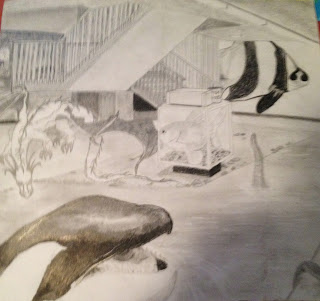Oh boy
Tis the season for me to shut down my entire social life for lesson planning, painting, and other homework! I have been developing a final lesson for my ArtEd class and I wanted to post the bare bones of it on here :) I actually did a variation of this lesson when I was in high school - all those years ago haha - and I wanted to edit it for my own use. I chose some traditional and some contemporary artists to mix things up and I think it will be fairly successful. I only have to present it to my teacher and classmates - the real challenge would be in the high school art room!
What’s Wrong with This Picture? ACCEPT IT!
Grade
Level: High school
Time: 12 One
hour class periods
Enduring
Idea/Theme: Perspective and Realistic Drawing
Rationale:
 Students will practice realistic drawing, learn drawing and shading
techniques and use technology to aid them in creating a final image. Using iPad
photography throughout the school, students will draw perspective lines onto an
image of a familiar space or scene. Students will become familiar with
postmodern principles such as juxtaposition, play, appropriation, and
exploration by manipulating their environment in some significant way. Change
and transformation are ideas communicated across multiple disciplines, not just
artmaking. Students will choose how to alter the environment with the drawing
techniques they have learned. Students will connect with their drawn
environment through the alterations and changes they apply to the image.
Students should use resource imagery to create realism if that is the desired
effect of their changes.
Students will practice realistic drawing, learn drawing and shading
techniques and use technology to aid them in creating a final image. Using iPad
photography throughout the school, students will draw perspective lines onto an
image of a familiar space or scene. Students will become familiar with
postmodern principles such as juxtaposition, play, appropriation, and
exploration by manipulating their environment in some significant way. Change
and transformation are ideas communicated across multiple disciplines, not just
artmaking. Students will choose how to alter the environment with the drawing
techniques they have learned. Students will connect with their drawn
environment through the alterations and changes they apply to the image.
Students should use resource imagery to create realism if that is the desired
effect of their changes.
Key
Concepts about the Enduring Idea:
Perspective helps us to create a 3D image on a 2D surface.
Depth cues are essential to effective perspective drawing.
Juxtaposition can sometimes change the purpose or function of the image
in which it appears.
Not every environment is what it appears to be.
Certain environments have certain purposes; but their meaning can be
altered.
Key
Artistic Concepts:
Juxtaposition, appropriation, play, observation, drawing, cross
hatching, line quality, envision, stretch and explore, overlap and layering,
perspective
Essential
Question(s)
How can juxtaposition change the meaning of an image or space?
How can I transform a familiar space?
Why did I choose these images/objects to transform the space?
Does change create chaos or unity?
Lesson
Objective(s):
Students will refine their drawing techniques by drawing from
photographic images and mastering techniques such as hatching, cross hatching,
and brightness changes (shading).
Students will choose images, objects, or techniques that are personally
significant to them and be able to explain their importance.
Students will explore the concept of alteration and change in terms of
emotional, cognitive, and artistic impact.
Standards:
ART.VA.II.HS.6 Use emergent technologies and materials to
create artistic
products that demonstrate knowledge of context, values,
and aesthetics.
(21st Century Skills: I.1, II.1, II.2,
II.3, III.2, III.7)
ART.VA.II.HS.1 Identify, define problems, and reflect upon
possible visual
solutions.
(21st Century Skills: I.2, I.3, I.4)
ART.VA.III.HS.1 Analyze and describe the formal
characteristics of a work
of art or design.
(21st Century Skills: I.3, II.1, III.1)
ART.VA.I.HS.2 Intentionally use art materials and tools when applying
techniques and skills to communicate ideas.
(21st Century Skills: I.6, III.3, III.6)
ART.VA.II.HS.5 Reflect, articulate, and edit the development of artwork
throughout the creative process.
(21st Century Skills: I.4, II.7, III.3, III.4)
ART.VA.III.HS.5 Recognize and understand the relationships between
personal experiences and the development of artwork.
(21st Century Skills: I.3)
Assessment:
Students will be assessed on the following: Explanation of work,
interpretation, drawing accuracy, utilization of materials, amount of changes
made (to be counted on back of image), unpredictability of changes, attention
to detail and form, class discussion and participation.
Evidence:
Students will display their work in the hallway from where they drew
inspiration. Example: stairwell drawing – student hangs work near stairwell or
ideally from where they took the picture/drew the image. This will create a
connection between the reality of the space and the changes the students made
in their work. Will the space be recognizable or not? Students are required to
explain the meaning or significance of their changes in the image. Explanation
of choices will be part of the grading process.
Key Artists:
Raphael, Albrecht
Dürer, Robert Gonsalves, Sandy Skoglund
Art Materials
List:
Projector & computer
iPads
Printer
Heavy weight drawing paper
Sketchbooks
Drawing pencils
Regular pencils
Fixative
Rulers
Erasers
Mat cutter
Mat board
Foam core/cardboard backing (students choice)
I put together a presentation to go with the lesson and I will present that to my classmates. I really just want to teach it to students!! I am so ready to graduate it's not even funny... alas. I am not yet done with my classes.
Until then, I will continue to soldier on and create awesome lesson plans.
Ms. K

